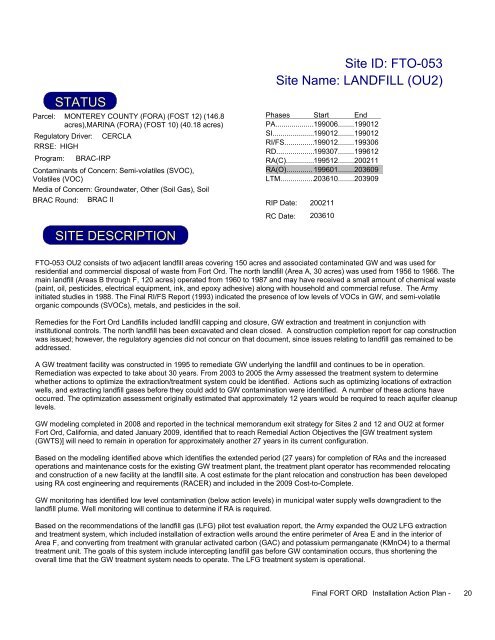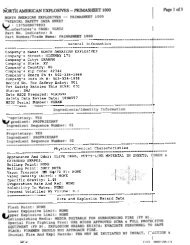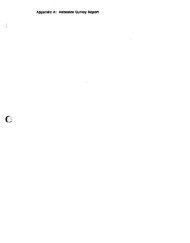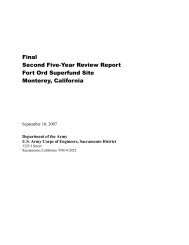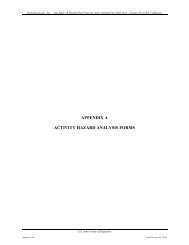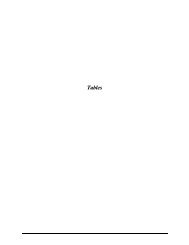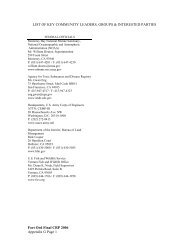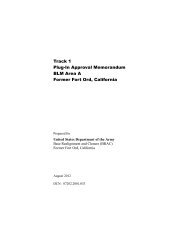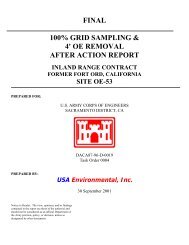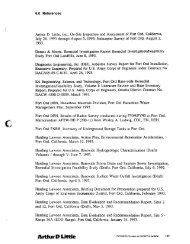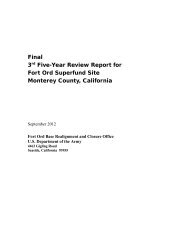FY2009 - Former Fort Ord - Environmental Cleanup
FY2009 - Former Fort Ord - Environmental Cleanup
FY2009 - Former Fort Ord - Environmental Cleanup
You also want an ePaper? Increase the reach of your titles
YUMPU automatically turns print PDFs into web optimized ePapers that Google loves.
STATUS<br />
Parcel: MONTEREY COUNTY (FORA) (FOST 12) (146.8<br />
acres),MARINA (FORA) (FOST 10) (40.18 acres)<br />
Regulatory Driver: CERCLA<br />
RRSE: HIGH<br />
Program: BRAC-IRP<br />
Contaminants of Concern: Semi-volatiles (SVOC),<br />
Volatiles (VOC)<br />
Media of Concern: Groundwater, Other (Soil Gas), Soil<br />
BRAC Round: BRAC II<br />
SITE DESCRIPTION<br />
Site ID: FTO-053<br />
Site Name: LANDFILL (OU2)<br />
Phases Start End<br />
PA................... 199006........ 199012<br />
SI..................... 199012........ 199012<br />
RI/FS............... 199012........ 199306<br />
RD................... 199307........ 199612<br />
RA(C).............. 199512........ 200211<br />
RA(O).............. 199601........ 203609<br />
LTM................. 203610........ 203909<br />
RIP Date:<br />
200211<br />
RC Date: 203610<br />
FTO-053 OU2 consists of two adjacent landfill areas covering 150 acres and associated contaminated GW and was used for<br />
residential and commercial disposal of waste from <strong>Fort</strong> <strong>Ord</strong>. The north landfill (Area A, 30 acres) was used from 1956 to 1966. The<br />
main landfill (Areas B through F, 120 acres) operated from 1960 to 1987 and may have received a small amount of chemical waste<br />
(paint, oil, pesticides, electrical equipment, ink, and epoxy adhesive) along with household and commercial refuse. The Army<br />
initiated studies in 1988. The Final RI/FS Report (1993) indicated the presence of low levels of VOCs in GW, and semi-volatile<br />
organic compounds (SVOCs), metals, and pesticides in the soil.<br />
Remedies for the <strong>Fort</strong> <strong>Ord</strong> Landfills included landfill capping and closure, GW extraction and treatment in conjunction with<br />
institutional controls. The north landfill has been excavated and clean closed. A construction completion report for cap construction<br />
was issued; however, the regulatory agencies did not concur on that document, since issues relating to landfill gas remained to be<br />
addressed.<br />
A GW treatment facility was constructed in 1995 to remediate GW underlying the landfill and continues to be in operation.<br />
Remediation was expected to take about 30 years. From 2003 to 2005 the Army assessed the treatment system to determine<br />
whether actions to optimize the extraction/treatment system could be identified. Actions such as optimizing locations of extraction<br />
wells, and extracting landfill gases before they could add to GW contamination were identified. A number of these actions have<br />
occurred. The optimization assessment originally estimated that approximately 12 years would be required to reach aquifer cleanup<br />
levels.<br />
GW modeling completed in 2008 and reported in the technical memorandum exit strategy for Sites 2 and 12 and OU2 at former<br />
<strong>Fort</strong> <strong>Ord</strong>, California, and dated January 2009, identified that to reach Remedial Action Objectives the [GW treatment system<br />
(GWTS)] will need to remain in operation for approximately another 27 years in its current configuration.<br />
Based on the modeling identified above which identifies the extended period (27 years) for completion of RAs and the increased<br />
operations and maintenance costs for the existing GW treatment plant, the treatment plant operator has recommended relocating<br />
and construction of a new facility at the landfill site. A cost estimate for the plant relocation and construction has been developed<br />
using RA cost engineering and requirements (RACER) and included in the 2009 Cost-to-Complete.<br />
GW monitoring has identified low level contamination (below action levels) in municipal water supply wells downgradient to the<br />
landfill plume. Well monitoring will continue to determine if RA is required.<br />
Based on the recommendations of the landfill gas (LFG) pilot test evaluation report, the Army expanded the OU2 LFG extraction<br />
and treatment system, which included installation of extraction wells around the entire perimeter of Area E and in the interior of<br />
Area F, and converting from treatment with granular activated carbon (GAC) and potassium permanganate (KMnO4) to a thermal<br />
treatment unit. The goals of this system include intercepting landfill gas before GW contamination occurs, thus shortening the<br />
overall time that the GW treatment system needs to operate. The LFG treatment system is operational.<br />
Final FORT ORD Installation Action Plan - 20


